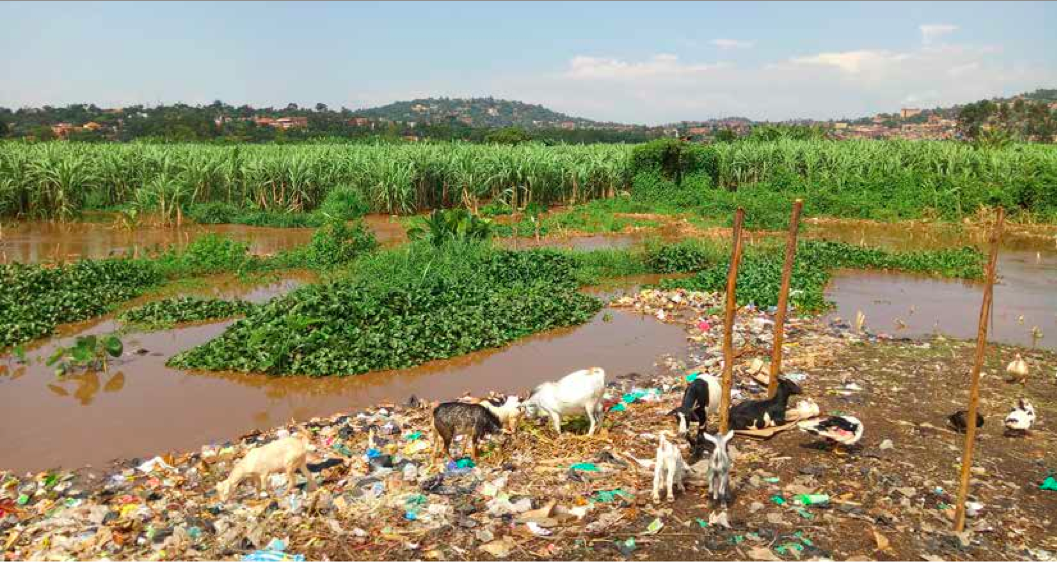Food or water? Safety from floods or increased household incomes? Climate change mitigation or wastewater treatment?
These are some of the tough trade-offs that users of wetlands in the Nile River basin are increasingly confronted with, as wetland areas become overexploited, deteriorate and ultimately fail to provide the benefits that communities and ecosystems depend on.
Kampala water supply is threatened by wetland overuse in Uganda
In Uganda, just outside Kampala, Jasenta Kyampaire has been growing sugarcanes in the Nakivubo wetland for the past 30 years. While the wetland has changed significantly during that time—with new fences and walls partitioning the area into smaller plots for various uses—she has continued to shift her garden into new parts of the wetland.

She is one of hundreds of community members living in and around the wetland who are making a living from it. People use the wetland for growing sugarcane and yams; mining sand; collecting water; and harvesting fodder for livestock. Researchers have found that, on average, the wetland provides each household with a value worth more than 14,800 USD per hectare per year, representing very significant earnings in a country where unemployment is high.
However, scientists also found that the benefits local households are harvesting from the Nakivubo wetland come at a serious expense: More than half the wetland has been significantly altered due to human activity, and this encroachment is hampering the wetland’s ability to filter and treat wastewater originating from the city of Kampala.
The consequence, ultimately, scientists say, can be compromised water quality in the Murchison Bay, the place that supplies freshwater for the 1.2 million people living in Kampala.

Strategies for coping with droughts challenge climate change mitigation in Tanzania
Also in Tanzania, wetlands are at risk. Scientists studied the use of wetlands in the Ihemi investment cluster in the SAGCOT corridor, where frequent climate change-induced droughts are challenging farmers’ productivity.
Therefore, smallholder farmers opt to farm crops in wetlands and valley bottoms where they can benefit from available water and moisture during both the rainy and the dry season. The practice, called vinyungu farming, allows farmers to grow crops all year round, significantly strengthening their food security.
But, just like in Uganda, this intensive farming of wetlands is creating other challenges: deterioration of land resources, pollution from pesticides and fertilizers, and intensive, uncoordinated use of water resources, which is creating conflicts between water users. Likewise, both socio-economic and ecological benefits originating from wetlands are being compromised.
In addition, scientists point out, wetlands play a critical role in mitigating the effects of climate change by functioning as carbon dioxide sinks, helping to reduce the amount of carbon in the atmosphere. Therefore, paradoxically, the current overuse of wetlands in the Ihemi cluster, prompted in part by droughts, could lead to even more frequent droughts in the future.
Solutions for improved management of wetlands
Almost 95 percent of all water on land that provides vital ecosystems services for humans, wildlife and livestock is stored in wetlands.
For the Nakivubo wetland in Uganda, researchers recommend restoring the area with natural vegetation, limiting agricultural activities and developing a comprehensive wetland management plan. Naturally, such interventions would need careful consideration, as local communities are currently obtaining significant benefits from the wetland.
Scientists also note that while it is mostly men (59.2 percent) that carry out business in the Nakivubo wetland, women are more likely than men to be negatively affected by evictions from or bans on exploitation of wetland resources.
The research team developed a set of guidelines on how to valuate the services provided by wetlands, arguing that a unified model for valuing ecosystem services derived from wetlands can help establish their worth and ensure sustainable use. For example, the risk of pollution of Murchison Bay in Uganda could perhaps be averted if the true value of the wetland is well documented and understood.
Also in Tanzania, scientists provided local communities, policy makers, extension agents and private sector actors with guidelines on sustainable management of wetlands.
The ultimate aim is for the guidelines to help decision makers balance trade-offs and coming up with strategies that ensure both agricultural productivity and sustainable wetland management. For example, harvesting rainwater during the wet season and storing it for use during the dry season could represent an alternative to the current farming of wetlands. Scientists presented such recommendations to stakeholders in the Ihemi cluster during a meeting in October, where they were well received.
Acknowledgment
This research was carried out by two projects:
- ‘Laying the Foundations for Effective Landscape-Level Planning for Sustainable Development in the SAGCOT Corridor’, led by The Nature Conservancy.
- ‘Nile Ecosystems Valuation for Wise Use’, led by the Nile Basin Capacity Building Network.
Both were part of WLE's regional program in the Nile and East Africa Region, a research-for-development initiative that sought to restore and bolster opportunities for increased agricultural productivity through key ecosystem services, especially in the resource poor areas of the region.

